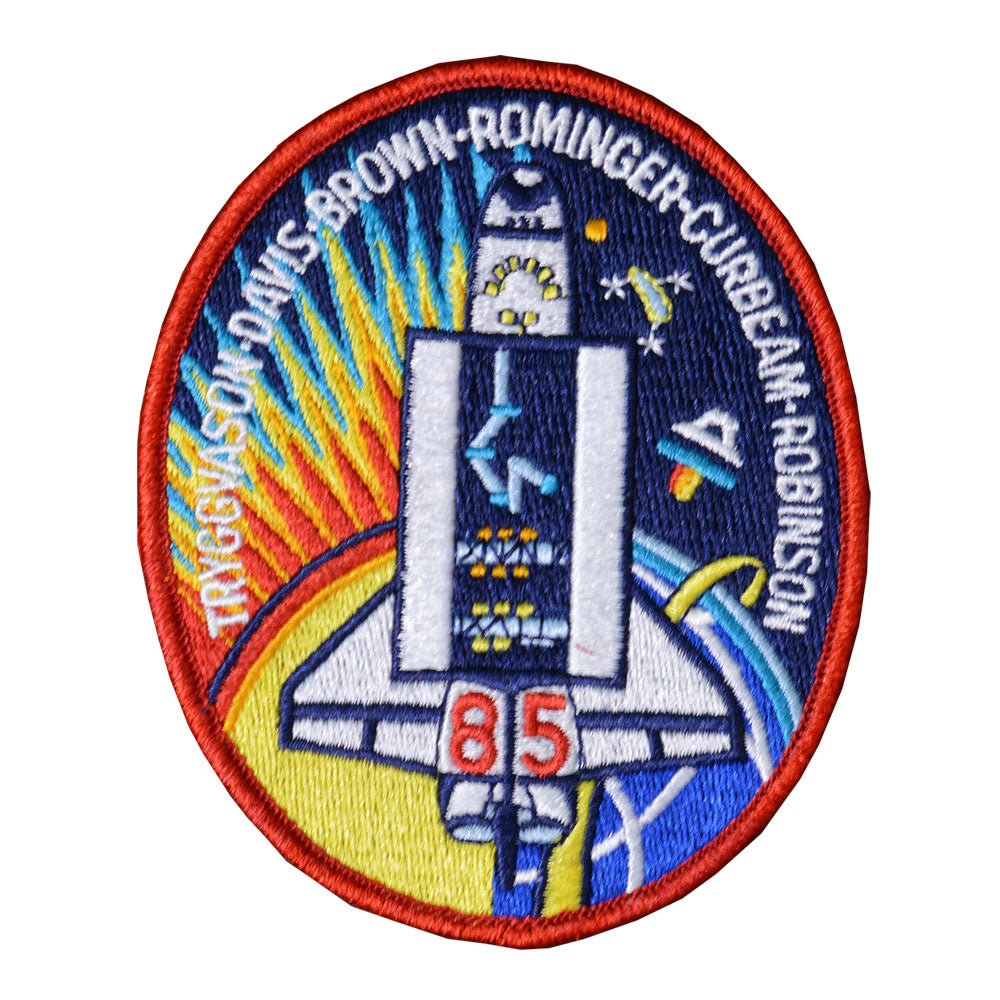
STS-85 Patch
STS-85 Patch
Mission Highlights
STS-85 Mission Patch STS-85 carried a complement of payloads in the cargo bay that focused on Mission to Planet Earth objectives as well as preparations for International Space Station assembly: the Cryogenic Infrared Spectrometers and Telescopes for the Atmosphere-Shuttle Pallet Satellite-2 (CRISTA-SPAS-02); the Japanese Manipulator Flight Development (MFD); the Technology Applications and Science-01 (TAS-1) and the International Extreme Ultraviolet Hitchhiker-02 (IEH-02).
This was second flight of CRISTA-SPAS payload. CRISTA-SPAS-02 also represented the fourth mission in a cooperative venture between the German Space Agency (DARA) and NASA. Payload included three telescopes and four spectrometers, deployed on flight day one, to gather data about Earth’s middle atmosphere. After more than 200 hours of free flight, CRISTA-SPAS was retrieved on Aug. 16. The three CRISTA telescopes collected 38 full atmospheric profiles of the middle atmosphere. A total of 22 sounding rockets and 40 balloons were launched to provide correlating data. Complementary instrument, the Middle Atmosphere High Resolution Spectrograph Investigation (MAHRSI) also performed well. Data from STS-85 and first CRISTA-SPAS flight, STS-66 in 1994, expected to yield new insight into distribution of ozone in Earth’s atmosphere. Once science operations were complete, CRISTA-SPAS was used in a simulation exercise to prepare for first International Space Station (ISS) assembly flight, STS-88, with the payload being manipulated as if it were the Functional Cargo Block (FGB) that will be attached to ISS Node 1.
TAS-1 was a Hitchhiker payload carrying eight experiments designed to demonstrate faster, better, cheaper avionics and processes: Solar Constant Experiment (SOLCON), Infrared Spectral Imaging Radiometer (ISIR) and Shuttle Laster Altimeter (SLA), all part of NASA’s Mission to Planet Earth program; and the Critical Viscosity of Xenon (CVX), Space Experiment Module (SEM); Two Phase Flow (TPF); Cryogenic Flight Experiment (CFE) and Stand Alone Acceleration Measurement Device and the Wide Band Stand Alone Acceleration Measurement Device (SAAMD/WBSAAMD). All the experiments were completed successfully.
MFD designed to evaluate use of the Small Fine Arm that will be part of the future Japanese Experiment Module’s Remote Manipulator System on ISS. Despite some glitches, MFD completed a series of exercises by crew on orbit as well as operators on ground. Two unrelated Japanese experiments, Two-Phase Fluid Loop Experiment (TPFLEX) and Evaluation of Space Environment and Effects on Materials (ESEM), were mounted near the Small Fine Arm in the payload bay.
IEH-02 was flying a second time and consisted of four experiments, all of which performed well on-orbit: Solar Extreme Ultraviolet Hitchhiker-2 (SEH); Ultraviolet Spectrography Telescope for Astronomical Research (UVSTAR); Distribution and Automation Technology Advancement – Colorado Hitchhiker and Student Experiment of Solar Radiation (DATA-CHASER); and Shuttle Glow Experiment-5 and -6, all with common objective to investigate solar extreme ultraviolet (EUV) flux and EUV emissions of the Jupiter Io plasma torus system.
In-cabin payloads: Bioreactor Demonstration System-3 (BDS-3), a cell biology research payload which has flown previously. On this flight, BDS used for growing colon cancer cells to a larger size than can be achieved on Earth. Protein Crystal Growth – Single locker Thermal Enclosure System (PCG-STES); Midcourse Space Experiment (MSX); Shuttle Ionospheric Modification with Pulsed Local Exhaust (SIMPLEX); Southwest Ultraviolet Imaging System (SWUIS), used to observe the Hale-Bopp comet; two Get Away Special (GAS) payloads; Biological Research in Canisters-10 (BRIC-10), one in a series of flights; and the Solid Surface Combustion Experiment (SSCE).
Crew also worked with the Orbiter Space Vision System (OSVS), which will be used during ISS assembly. OSVS features series of dots strategically placed on various payload and vehicle stuctures that permit precise alignment and pointing capability.
Orbiter performance was nominal throughout the mission.


